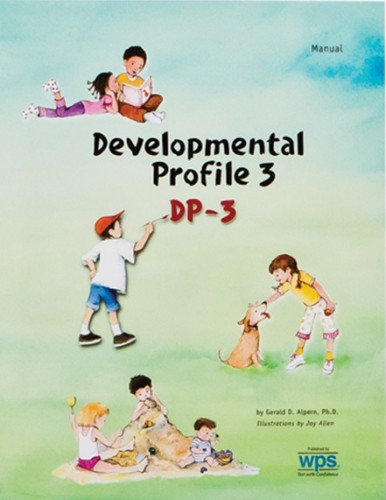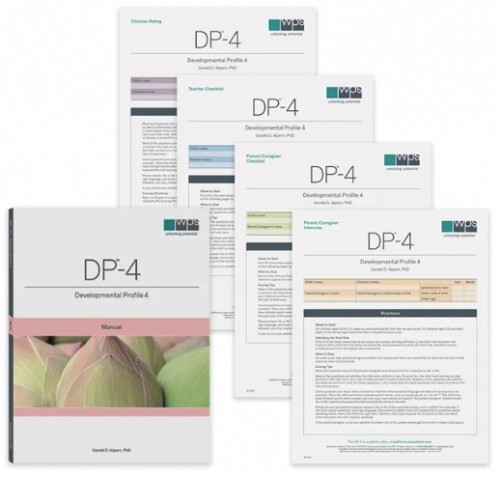This fully revised third edition of the Developmental Profile strengthens and updates an instrument already considered the best of its kind. Like previous versions, the DP-3 evaluates children’s functioning in five key areas, in just 20 to 40 minutes. However, this edition adds norm-based standard scores, an expanded age range, updated item content, clearer interpretive guidelines, a nationally representative standardization sample, new empirical studies demonstrating its reliability and validity, and unlimited computer scoring and interpretation.
Comprehensive Yet Quick
Designed to evaluate children from birth through age 12 years, 11 months, the DP-3 includes 180 items, each describing a particular skill. The respondent simply indicates whether or not the child has mastered the skill in question.
The DP-3 provides a General Development score as well as the following scale scores:
- Physical - Large- and small-muscle coordination, strength, stamina, flexibility, and sequential motor skills
- Adaptive Behavior - Ability to cope independently with the environment—to eat, dress, work, use current technology, and take care of self and others
- Social–Emotional - Interpersonal skills, social–emotional understanding, functioning in social situations, manner in which child relates to peers and adults
- Cognitive - Intellectual abilities and skills prerequisite to academic achievement
- Communication - Expressive and receptive communication skills, including written, spoken, and gestural language
Within each scale, basals and ceilings are used, so you don’t have to administer all 180 items. And because each scale has its own norms, you don’t have to use all five scales if you’re interested in just one.
Ideal for Routine Screening or Focused Assessment
Because the DP-3 is comprehensive yet quick and cost-effective, it makes routine screening feasible. You can administer the test to large groups of children knowing that it will alert you to any significant problems that may be present.
Or you can use the DP-3 when you have a specific question about a particular child. It’s an effective way to investigate puzzling behavior, respond to parental concerns, or follow up on teacher observations. The test can lead to answers even when you have only a hunch that the child may have a problem.
A Convenient New Administration Option
While a parent interview is the preferred method of administration, the DP-3 offers an alternative that’s useful when a face-to-face meeting is not possible. The Parent/Caregiver Checklist contains the same item content as the Interview Form (though language has been altered slightly). Written at a sixth-grade reading level, the checklist can be completed, without your supervision, by the child’s parent or other caregiver who is knowledgeable about the child’s functioning.
Five Score Formats
DP-3 scores are available in five formats: standard scores, percentile ranks, stanines, age equivalents, and descriptive ranges. This gives you flexibility in using, reporting, and explaining test results. For example, you might choose standard scores for eligibility determination or progress monitoring; age equivalents for parent conferences; and stanines or percentiles for school records.
Norms are based on a sample of 2,216 typically developing children representative of the U.S. population in regard to ethnicity, geography, and socioeconomic status.
Unlimited Computer Scoring and Interpretation
Provided on an unlimited-use CD, the DP-3 computer program saves time, reduces the chance of error, and provides both scoring and interpretation. It gives you highly useful reports, with the following features:
- Graphical Representation of Scores: You can easily spot advanced or delayed development across the five scales and the General Development score.
- Scale Pattern Analysis and Scale-by-Scale Item Analysis: These calculations—which are difficult or impossible in hand scoring—reveal statistical significance in the pattern of strengths and weaknesses and pinpoint skills not mastered that fall below the child’s ability level on each scale.
- Individualized Intervention Activities: For each scale, the program suggests teaching activities that address the child’s specific weaknesses.
- Clinician and Parent Reports: The CD generates a thorough clinical report for professionals and an easy-to-understand summary for parents. Both can be easily customized.
IDEA Compliance
Because the DP-3 meets federal criteria for evaluating children with developmental problems, it’s useful in helping determine eligibility for special education, planning IEPs, and implementing periodic screening programs. Its five scales correspond to the five domains specified in IDEA for assessing developmental delays. In addition, the DP-3’s interview format and provision of a parent report satisfy the federal requirement that parents be involved in their child’s assessment.
The DP-3 is an excellent way to identify developmental strengths and weaknesses early in a child’s life. Its norm-based standard scores allow you to compare children’s functioning with that of their peers, design interventions that meet their particular needs, and monitor their progress over time.
- Copyright 2007

 Proud to be Canadian
Proud to be Canadian
